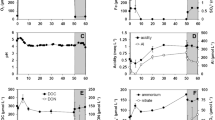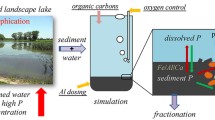Abstract
This work assessed both the fractionation and the seasonal mobility variations of Ga and In in systems impacted by acidic thermal waters. This was accomplished by performing thermodynamic calculations using the PHREEQC algorithm and by assessing the activity of acidophilic iron-oxidizing bacteria. The pH of the Kusatsu thermal waters in Gunma Prefecture, central Japan, is rapidly increased following the addition of a lime suspension. After an abrupt pH increase, under which conditions free ions of Ga and In and their complexes with Cl− and SO42− exist only in negligible quantities, the majority of dissolved Ga and In is removed by sorption onto suspended hydrous ferric oxides (HFOs). These HFOs are then transported to an artificial lake without significant sedimentation along the river. Subsequently, the suspended HFOs settle out and are added to sediments without significant fractionation between Ga and In. The Tamagawa thermal waters in Akita Prefecture, northeast Japan, are also treated with lime. However, complete neutralization requires mixing with some tributary streams, leading to a gradual downstream increase in pH. Dissolved Ga is, in general, sorbed by HFOs in upstream areas, leading to wide dispersal of Ga across the entire watershed. In comparison, In is transported to the lake inlet predominantly as a Cl− complex species without significant removal along the river, with the majority being precipitated in an artificial lake, where Cl− concentrations are too low to form stable complex species with In, and thus, dissolved In is sorbed by HFOs. As a result, In is effectively concentrated within downstream lakebed sediments, whereas Ga is dispersed along the river. Seasonal variations in Ga mobility within the Tamagawa field between snowmelt and low-flow seasons are primarily controlled by pH, because hydrolysis reactions of these metals, which are related to sorption reactions, tend to occur in the upstream regions in the snowmelt season. However, under warmer conditions, HFO formation preferably occurs due to the activity of acidophilic iron-oxidizing bacteria. Thus, under similar pH variations, dissolved Ga is more effectively removed by HFOs during warmer seasons. On the contrary, because HFOs are abundantly formed in low-flow season, even under colder conditions, before In hydrolysis reaction starts to occur, In mobility is less affected by water temperature and then bacterial activity.









Similar content being viewed by others
References
Bourg ACM, Kedziorek MAM, Crouzet C (2006) Seasonal cycles of dissolved Cd, Mn and Zn in river water caused by variations in pH Induced by biological activity. Aquat Geochem 6:461–471
Brown KL (1986) Gold deposition from geothermal discharges in New Zealand. Econ Geol 81:979–983
Chen HW (2006) Gallium, indium and arsenic pollution of groundwater from a semiconductor manufacturing area of Taiwan. Bull Environ Contam Toxicol 77:289–296
Elbaz-Poulichet F, Martin JM, Huang WW, Zhu JX (1987) Dissolved Cd behaviour in some selected french and chinese estuaries. Consequences on Cd supply to the ocean. Mar Chem 22:125–136
Feitknecht W, Schindler P (1963) Solubility constants of metal oxides, metal hydroxides and metal hydroxide salts in aqueous solution. Pure Appl Chem 6:130–199
Fournier RO, Kennedy BM, Aoki M, Thonpson M (1994) Correlation of gold in siliceous sinters with 3He/4He in hot spring waters of Yellowstone National Park. Geochim Cosmochim Acta 58:5401–5419
Gammons CH, Nimick AD, Parker SR, Cleasby TE, McCleskey RB (2005) Diel behavior of iron and other metals in a mountain stream with acid to neutral pH: Fisher Creek, Montana, USA. Geochim Cosmochim Acta 69:2505–2516
Kajiwara M, Ogawa Y, Tsuchiya N (2011) Experimental study on sorption and fractionation behaviors of rare metals (In, Ga) and toxic elements (As, Pb) in acidic river. Shigen Chishitsu 61:167–180 (in Japanese with English abstract)
Kimball BA, Callender E, Axtmann EV (1995) Effects of colloids on metal transport in a river receiving acid mine drainage, upper Arkansas River, Colorado, U.S.A. Appl Geochem 10:285–306
Lewis AJ, Palmer MR, Sturchio NC, Kemp AJ (1997) The rare earth element geochemistry of acid-sulphate and acid-sulphate-chloride geothermal systems from Yellowstone National Park, Wyoming, USA. Geochim. Cosmochim. Acta 61:695–706
Lin CF, Chang KF, Tsay TW, Lee DY, Lo SL, Yasunaga T (1997) Adsorption mechanism of gallium(III) and indium(III) onto γ-Al2O3. J Colloid Interface Sci 188:201–208
Masson M, Schäfer J, Blanc G, Pierre A (2007) Seasonal variations and annual fluxes of arsenic in the Garonne, Dordogne and Isle Rivers, France. Sci Total Environ 373:196–207
Nimick DA, Gammons CH, Cleasby TE, Madison JP, Skaar D, Brick CM (2003) Diel cycles in dissolved metal concentrations in stream: occurrence and possible causes. Water Resour Res 39:1247. https://doi.org/10.1029/2002WR001571
Noike T, Nakamura K, Matsumoto J (1983) Oxidation of ferrous iron by acidophilic iron-oxidizing bacteria from stream receiving acid mine drainage. Water Res 17:21–27
Nozaki Y, Lerche D, Alibo DS, Tsutsumi M (2000) Dissolved indium and rare earth elements in three Japanese rivers and Tokyo Bay: evidence for anthropogenic Gd and In. Geochim Cosmochim Acta 64:3975–3982
Ogawa Y, Ishiyama D, Shikazono N, Iwane K, Kajiwara M, Tsuchiya M (2012) The role of hydrous ferric oxide precipitation in the fractionation of arsenic, gallium, and indium during the neutralization of acidic hot spring water by river water in the Tama River watershed, Japan. Geochim Cosmochim Acta 86:367–383
Ogawa Y, Ishiyama D, Shikazono N, Iwane K, Kajiwara M, Tsuchiya M (2013) Fractionation and deposition of indium and arsenic from the Kusatsu and Tamagawa acidic hot springs, Japan: possible man-made analogues for rare metal concentrations onto lake beds? Econ Geol 108:1641–1656
Ogawa Y, Yamada R, Shinoda K, Inoue C, Tsuchiya N (2014) The fate of arsenic in a river acidified by volcanic activity and an acid thermal water and sedimentation mechanism. Environ Sci Process Impacts 16:2325–2334
Olivie-Lauquet G, Gruau G, Dia A, Riou C, Jaffrezic A, Henin O (2001) Release of trace elements in wetlands: role of seasonal variability. Water Res 35:943–952
Parkhurst DL, Appelo CAJ (2013) Description of input and examples for PHREEQC version 3—A computer program for speciation, batch-reaction, one-dimensional transport, and inverse geochemical calculations. US Geological Survey Techniques and Methods, book 6, chap. A43, vol 3, pp 1–504
Pope JG, Brown KL, McConchie DM (2005) Gold concentrations in springs at Waiotapu, New Zealand: implications for precious metal deposition in geothermal systems. Econ Geol 100:677–687
Rae AJ, Cooke DR, Brown KL (2011) The trace metal chemistry of deep geothermal water, Palinpinon geothermal field, Negros Island, Philippines: implications for precious deposition in epithermal gold deposits. Econ Geol 106:1425–1446
Satoh H (2010) Hydrothermal system of acidic thermal water associated with volcanic activities and origin, transportation and precipitation of elements in the thermal water. Ph.D. Thesis, Akita University, Japan (in Japanese with English abstract)
Schindler PW, Stumm W (1987) The surface chemistry of oxides, hydroxides and oxide minerals. In: Stumm W (ed) Aquatic surface chemistry. Wiley, Hoboken, pp 83–107
Shimada Y, Yonezu K, Okaue Y, Watanabe K, Iwanaga T, Yokoyama T (2010) Rare earth elements in silica scales from geothermal water. J Geother Res Soc Japan 32:77–86 (in Japanese with English abstract)
Singer PC, Stumm W (1970) Acid mine drainage: the rate-determining step. Science 167:1121–1123
Syu CH, Chien PH, Huang CC, Jiang PY, Juang KW, Lee DY (2017) The growth and uptake of Ga and In of rice (Oryza sative L.) seedlings as affected by Ga and In concentrations in hydroponic cultures. Ecotox Environ Saf 135:32–39
White SJO, Hussain FA, Hemond HF, Sacco SA, Shine JP, Runkel RL, Walton-Day K, Kimball BA (2017) The precipitation of indium at elevated pH in a stream influenced by acid mine drainage. Sci Total Environ 574:1484–1491
Wood SA (2003) The geochemistry of rare earth elements and yttrium in geothermal waters. In: Simmons SF, Graham I (eds) Volcanic, geothermal, and ore-forming fluids, Vol. 10. Rulers and Witnesses of Processes within the Earth Society of Economic Geology Special Publication. pp 133–158
Wood SA (2006) Rare earth element systematics of acidic geothermal waters from the Taupo Volcanic zone, New Zealand. J Geochem Explor 89:424–427
Wood SA, Samson IM (2006) The aqueous geochemistry of gallium, germanium, indium and scandium. Ore Geol Rev 28:57–102
Zeng C, Gonzalez-Alvarez A, Orenstein E, Field JA, Shadman F, Sierra-Alvarez R (2017) Ecotoxicity assessment of ionic As(III), As(V), In(III) and Ga(III) species potentially released from novel III-V semiconductor materials. Ecotox Environ Safe 140:30–36
Acknowledgements
This research is supported in part by the River Fund in charge of the Foundation of River and Watershed Environment Management (FOREM), Japan, and by the Water Resources Environment Technology Center (WEC), Japan. This manuscript was greatly improved by the valuable comments from two anonymous reviewers.
Author information
Authors and Affiliations
Corresponding author
Electronic supplementary material
Below is the link to the electronic supplementary material.
Rights and permissions
About this article
Cite this article
Ogawa, Y., Ishiyama, D., Shikazono, N. et al. Factors Controlling the Fractionation and Seasonal Mobility Variations of Ga and In in Systems Impacted by Acidic Thermal Waters: Effects of Thermodynamics and Bacterial Activity. Aquat Geochem 24, 5–25 (2018). https://doi.org/10.1007/s10498-018-9328-z
Received:
Accepted:
Published:
Issue Date:
DOI: https://doi.org/10.1007/s10498-018-9328-z




